Agoutis, Agoutis & More Agoutis
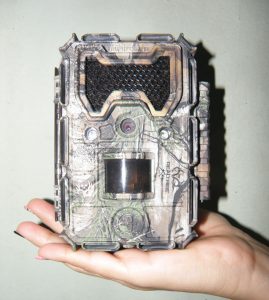
A Fun New Way of Monitoring Wildlife
by Jack Ewing
“Oh my God”, I blurted out to no one in particular. “Absolutely incredible”. A full grown puma was walking straight toward me on the computer screen. The two receptionists who were in office and heard my exclamation hurried over to see what I was so excited about. I restarted the 15-second video so everyone could see. An adult puma came walking straight at the camera, its eyes glowing from the infrared illumination. It looked like it was stalking the camera. At the last moment the large carnivore veered to the right and walked out of the field of view. It was a very exciting day. The presence of large carnivores in the Hacienda Baru National Wildlife Refuge was a clear indication of a healthy ecosystem. Since that first video in December of 2012 we have captured 87 more of pumas at four different locations within the refuge.
Trail cameras, also called camera traps, have been around for at least 35 years. The cost of these early trail cameras was so high that few researchers could afford them. The digital revolution brought revolutionary change to the cameras which quickly improved, and prices got lower. By 2010 prices ranged from several thousand dollars to less than $200. Camera traps were becoming affordable to the average nature lover. The cameras I use today are made by the Bushnell company. Amazon sells them for $139.95 each. They are triggered by an infrared sensor that detects warm blooded animals. The photos are stored on an SD memory chip which holds 1000s of photos or videos and is inexpensive.
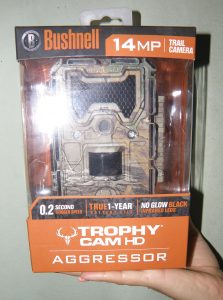
My first camera trap was a gift from my daughter. It was the beginning of a great adventure. Programing it was a real challenge for me, but once I had studied the instructions and gotten into the process it went well. There were settings for date and time, video or photos, resolution of the video or photos, if you choose photos you can program the camera to take one at a time or three in succession. I tried it out in the house taking photos of the dogs. It worked perfectly. I was ready to put it out in the rainforest. One of the guides suggested a location where there is a short bridge across a jungle stream and lots of animal tracks. We tied the camera to a tree at one end of the bridge.
I had decided to wait a week before retrieving the memory chip. With great anticipation I put the chip in my computer, and the first photo appeared on the screen, me backing away from the camera after turning it on. The next one was a coati approaching the bridge. I was elated. Until that moment I had been doubtful, but now I knew that it really did take pictures of wild animals. On that first chip there were photos of four different species in addition to the coati, a skunk, a paca, four collared peccaries, and about a dozen agoutis. I couldn’t have been happier. I called my daughter and thanked her again for the gift.
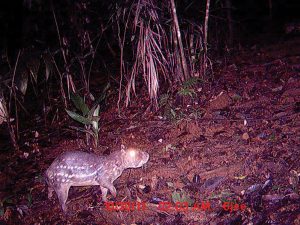
Several months later I brought back a chip that had jpg files on it, but for some reason my computer wouldn’t open them. I tried everything I could think of, but the files wouldn’t open. I finally decided that it was a lost cause, and almost deleted the contents of the chip. At the last moment I decided to try it with a different computer. To my delight it worked. To my astonishment the very first image to pop up on the monitor was an ocelot. I just sat there staring at the screen. After recovering from the initial shock, I called everyone over to see. Finally I got down to studying the photo. I decided that it was a female. Although she was walking at an angle toward the camera, and her rear end wasn’t visible, her udder was visible and was quite full. I surmised that she was either in late pregnancy or nursing a cub or cubs. There was a black object in her mouth, but the image was a little fuzzy. Several Hacienda Baru guides studied the image, and we determined that it was a spiny rat, the ocelot’s favored prey. Since that time my cameras have captured photos and videos of 88 more ocelots at about 15 different locations within the Hacienda Barú National Wildlife Refuge.
Other than being fun trail cameras are often used in scientific research. For example researchers who have worked at Hacienda Barú have used them to study animal behavior, diversity and frequency of mammal species, and monitoring locations where animals cross the highway through tunnels and over bridges. The Asociación Amigos de la Naturaleza del Pacifico Central y Sur (ASANA), has used them to determine the level of diversity of mammal species in the Path of the Tapir Biological Corridor (PTBC).
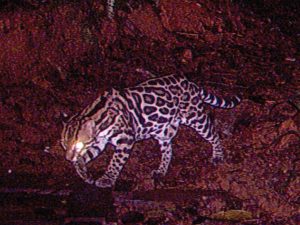
When highway #34, which passes right through Hacienda Barú National Wildlife Refuge, was in the planning stages we worked with the environmental impact study team to devise ways to mitigate the road kill. We asked them to build tunnels under the road and suspension bridges over the top. The biologists in charge were very cooperative, and we ended up with 21 tunnels and four bridges in a two kilometer stretch. We knew that animals had started using the tunnels almost immediately, because we could see their tracks, but no one had actually seen or photographed one. Later the highway department inquired about the tunnels, and we assured them that the project had achieved its goal, but that we had no proof to back up our words. I had six camera traps by that time, and decided to put one in a tunnel. I set the camera to take 15-second videos. Usually I check the cameras once a month, but I was so anxious to see if that camera had captured the evidence I was looking for that after five days I went out and got the memory chip. The results blew me away. There were a total of 33 videos of four different species walking through the tunnel, peccaries, pacas, coatis, and, of course, agoutis. The most impressive was a group of about 20 peccaries walking toward and past the camera. I posted it on the Hacienda Baru Facebook page. The video went viral. Messages and emails from interested individuals, government officials, biologists, and numerous Costa Rican environmental groups started pouring in. Some came from faraway places like Brazil and Argentina. Costa Rican environmental groups started pressuring the highway department to build animal crossings at their locations and even approached the national legislature about creating a law requiring that tunnels be included in all new highway construction that passes through a national park or wildlife refuge. The people from the highway department who had helped get the project approved were elated. Now they had proof that the funds had been well spent.
The more I worked with trail cameras the more I learned. That first Moultrie brand camera took excellent quality photos and videos, as you can see in the image of the ocelot. The main drawback to it was the visible flash for nocturnal photos. Animals didn’t like it. Whenever I mounted the camera in a new location it would capture lots of photos or videos the first week. As time went by there were less and less nocturnal images. I reasoned that the animals quickly learned that every time they walked past that location a bright light would flash in their eyes, so they changed their habitual route to avoid it. Later cameras started appearing on the market with infrared illumination. These were better, but there was still a red glow from the infrared LED bulbs. The Bushnell cameras I use today are called “no glow” and have no visible light at night. Learning where to place the cameras so they will capture the most and best quality images comes with experience. Wildlife often follows walking trails for people. One important trick is to aim the camera down the trail rather than across it. Once the infrared sensor triggers the shutter there is a one to two second delay before it starts recording images. An animal walking past a camera can trigger it and be outside the field of view by the time the photo is snapped. An animal walking toward or away from the camera will still be visible. Though they are water resistant the useful life of an unprotected trail camera in a rainforest is only about eight months. If you put a cover over it, the life is extended to about two years. We fashion a cover out of plastic gallon jugs for protection. This is an easy and inexpensive way to protect your cameras. Even with the cover I bring my cameras in after four months of use and give them a couple of days of hot sun to eliminate any internal humidity.
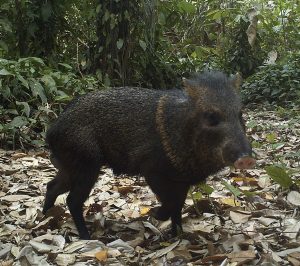
Our best camera location on Hacienda Barú is a place where five trails meet. Usually the camera at this location captures one or two videos of ocelots per month. Ocelots are lots of fun because every spot pattern is different and it is relatively easy to identify individuals. This year from March 10 to April 10 there were two, an adult female and a grown cub traveling separately. Probably the cub had been weaned and was on its own but still sharing the same territory with its mother. For the next one month period we saw the same two, but additionally there were three adult males, the one that normally occupied that territory and two more. One of these males was so large that at first I thought it was a jaguar. On June 1 at 7:20 PM the female stopped right in front of the camera, licked her paw, and continued onward. Thirty-four minutes later, the big male stopped in the same spot, sniffed the ground where the female had stopped, and continued on. Obviously, he was following her. I discussed this with a biologist friend who has several cameras about 50 kilometers south of here. His cameras had captured photos of three different males in April. We decided that the mating season had begun, the female was coming into heat, and the big male was following and biding his time until she was ready to mate. He had probably ousted the other two males from the territory. Due to this experience we now know that the mating season for ocelots in this part of Costa Rica includes April, May and June. I am anxious to see the offspring of that enormous male.
At the top of my wish list is the tapir. The Path of the Tapir Biological Corridor (PTBC) project was initiated in 1990. The last tapir of record in the area was shot by a hunter in 1957. There are tapirs in the Los Santos Forest Reserve at the north end of the corridor and in the Osa Peninsula to the south. The dream of the project is to restore enough natural habitat to the area so that these large mammals will return. If a tapir were to appear on one of my cameras or those of anyone else within the corridor it would be a clear indication that the dream is well on its way to realization. There are three other mammals on my wish list, the jaguar, the white-lipped peccary, and the bracket deer, all of which are very scarce or locally extinct.
During the period June 10 to July 10, 2016 the Local Council for the PTBC, placed cameras at certain locations along the length of the corridor with the goal of determining the presence and distribution of mammals. Also included were cameras of individuals who are cooperating with the project. My best camera was included. Before I sent the chip to the project coordinator I copied it to my computer. There were 367 videos, 300 of which were agoutis. Fourteen other species appeared on the chip: four birds—great curassow, great tinamou, blue-crowned mot mot, and a white-tipped dove; there were eleven mammals—collared peccary, skunk, tamandua (ant eater), squirrel, spiny rat, white-tailed deer, opossum, raccoon, paca, coati, and ocelot. Of the ocelots there were four videos which included two different males, the female and the grown cub.
Over the years my cameras have definitely captured more photos of agoutis than any other species. Every time I stick a chip in a computer to view the videos, I am anxious to see what appears. Nevertheless I am aware that in between the exciting species there will be agoutis, agoutis, and more agoutis.

